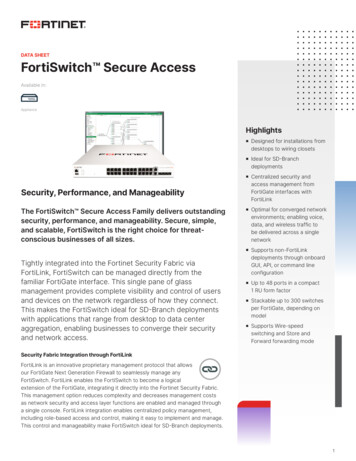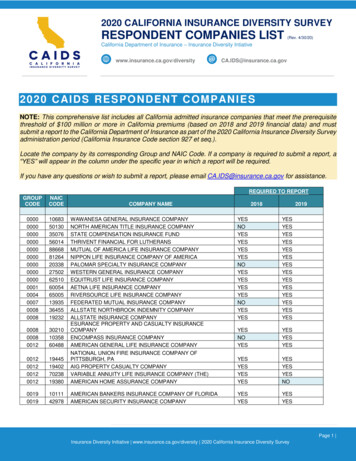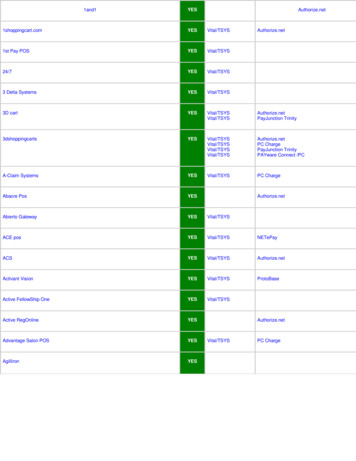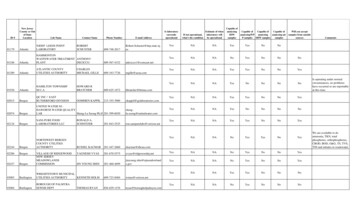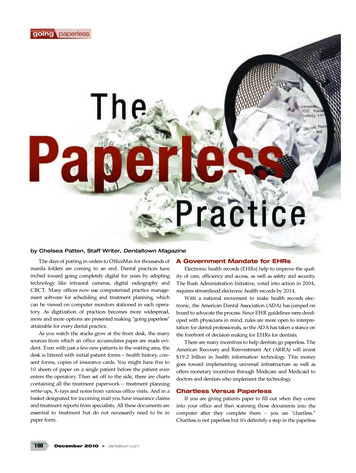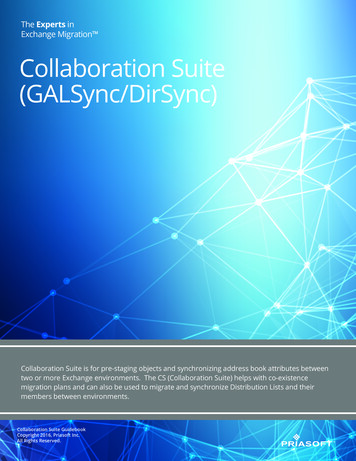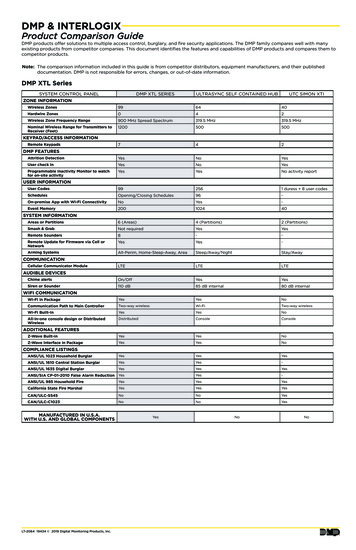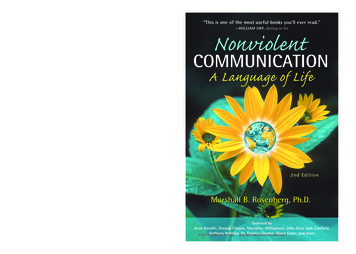
Transcription
Communication/Relationships/Self Help“This is one of the most useful books you’ll ever read.”— WILLIAM URY, Getting to YesCreate your life, your relationships andyour world in harmony with your valuesMost of us have been educated from birth to compete,judge, demand, and diagnose—to think and communicate in terms ofwhat is “right” and “wrong“ with people. At best, communicating andthinking this way can create misunderstanding and frustration. And stillworse, it can lead to anger, depression, and even emotional or physical violence.In this international bestseller, Rosenberg uses stories, conversation role-plays,and real-world examples to introduce his world-renowned, four-part NonviolentCommunication (NVC) process. Far more than a communication technique, you’lllearn to transform the thinking, language, and moralistic judgments that keepyou from the enriching relationships that you dream of. You’ll start to resolveconflicts with ease, more easily get what you want without using demands, beginto hear the needs of others with less struggle, strengthen your personal andprofessional relationships, and start living your fullest potential.With Nonviolent Communication, you’ll learn to: Put your primary focus on connection through empathic listening ratherthan “being right” or “getting what you want”Transform conflict into mutually satisfying outcomesDefuse anger and frustration peacefullyCreate personal and professional relationships grounded in mutual respect,compassion, and emotional safetyBreak patterns of thinking that lead to arguments or depressionMove beyond power struggles to cooperation and trust“Nonviolent Communication can change the world. More importantly, itcan change your life. I cannot recommend it highly enough.”— JACK CANFIELD, Chicken Soup for the Soul Series2nd Edition“In this book you’ll find amazingly effective language for saying what’son your mind and in your heart.”— VICKI ROBIN, Your Money or Your Life 19.95 USA 21.95 CANwww.NonviolentCommunication.comROSENBERGAround the world, NVC has been adopted by Fortune 500 companies, governmentoffices, schools, hospitals, university MBA and communication curriculum, communitymediation centers, anger management programs, peace and social change advocates,inmate rehabilitation programs, and more.Endorsed byArun Gandhi, Deepak Chopra, Marianne Williamson, John Gray, Jack Canfield,Anthony Robbins,Dr. Thomas Gordon, Riane Eisler, and more 2010 PuddleDancerPresswww.NonviolentCommunication.com
NVC.2e.17p.int.100625.sb.qxp:NVC Tradebook6/29/107:57 AMPage iNonviolentCOMMUNICATIONA Language of LifeMarshall B. Rosenberg, Ph.D.2240 Encinitas Blvd., Ste. D-911, Encinitas, CA 92024email@PuddleDancer.com 2010 PuddleDancer Press mTM
NVC.2e.17p.int.100625.sb.qxp:NVC Tradebook6/29/107:57 AMPage iiNonviolent Communication: A Language of Life 2003 PuddleDancer PressA PuddleDancer Press BookAll rights reserved. No part of this publication may be reproduced, distributed, or transmitted in anyform or by any means, including photocopying, recording, or other mechanical or electronic methods,without the prior written permission of the publisher, except for use as brief quotations embodied incritical reviews and certain other noncommercial uses as permitted by copyright law. To requestpermission, contact the publisher at the following address, “Attention: Permissions Coordinator.”PuddleDancer Press, Permissions Dept.2240 Encinitas Blvd., Ste. D-911, Encinitas, CA 92024Tel: 1-858-759-6963 Fax: 1-858-759-6967www.NonviolentCommunication.com Email@PuddleDancer.comOrdering InformationPlease contact Independent Publishers Group, Tel: 312-337-0747; Fax: 312-337-5985;Email: frontdesk@ipgbook.com or visit www.IPGbook.com for other contact informationand details about ordering onlineNonviolent Communication: A Language of Life2nd Edition Printing, August, 2003Author: Marshall B. Rosenberg, Ph.D.Editor: Lucy LeuCopyeditor: Kyra FreestarProject director: Jeanne IlerCover and interior design: Lightbourne (www.lightbourne.com)Indexer: Phyllis Linn, INDEXPRESSCover photograph of Jerusalem artichoke: Eric DresserManufactured in the United States of America2nd Edition, 1st Printing, August 200320 19 18 17ISBN: 978-1-892005-03-8Library of Congress Cataloging-in-Publication DataRosenberg, Marshall B.Nonviolent communication : a language of life / by Marshall B.Rosenberg. -- 2nd ed.p. cm.Includes bibliographical references and index.ISBN: 978-1-892005-03-81. Interpersonal communication. 2. Interpersonal relations. I.Title.BF637.C45R67 2003153.6--dc212003010831 2010 PuddleDancer Presswww.NonviolentCommunication.com
NVC.2e.17p.int.100625.sb.qxp:NVC Tradebook6/29/107:57 AMPage iiiWhat People Are Saying AboutNonviolent Communication TM:RELATIONSHIPS:“Marshall Rosenberg’s dynamic communication techniques transformpotential conflicts into peaceful dialogues. You’ll learn simple tools todefuse arguments and create compassionate connections with your family,friends, and other acquaintances.”—JOHN GRAY, author, Men Are From Mars, Women Are From Venus“Nonviolent Communication can change the world. More importantly, it canchange your life. I cannot recommend it highly enough.”—JACK CANFIELD, author, Chicken Soup for the Soul Series“Marshall Rosenberg provides us with the most effective tools to fosterhealth and relationships. Nonviolent Communication connects soul to soul,creating a lot of healing. It is the missing element in what we do.”—DEEPAK CHOPRA, author, How to Know God andAgeless Body and Timeless Mind“I have taken conversations that were headed for the dumps, starting usingthese techniques, and ended up with a very useful bonding experience.”—An Amazon.com reviewer“If you want to be heard, and to hear what your loved ones are trulysaying behind what there saying, read this book! It will change your life.”—An Amazon.com reviewer“Rosenberg has developed a simple method of communicating that helps toavoid triggering a defensive reaction, and instead stimulate understandingand agreement. It is invaluable in all your relationships, and definitelyshould be required reading for everyone.”—An Amazon.com reviewerCONFLICT TRANSFORMATION:“Nonviolent Communication is one of the most useful processes you willever learn.”—WILLIAM URY, coauthor, Getting to Yes“In this book, you will find an amazingly effective language for sayingwhat’s on your mind and in your heart. Like so many essential and elegantsystems, it’s simple on the surface, challenging to use in the heat of themoment and powerful in its results.”—VICKI ROBIN, coauthor, Your Money or Your Life 2010 PuddleDancer Presswww.NonviolentCommunication.com
NVC.2e.17p.int.100625.sb.qxp:NVC Tradebook6/29/107:57 AMPage iv“As far as nonviolence and spiritual activism, Marshall Rosenberg is it!Applying the concepts within these books will guide the reader towards afostering more compassion in the world.”—MARIANNE WILLIAMSON, author, Everyday Graceand honorary chairperson, Peace Alliance“Like Noam Chomsky, Rosenberg’s work is intrinsically radical, it subvertsour whole status-quo system of power: between children and adults, thesane and the psychotic, the criminal and the law. Rosenberg’s distinctionbetween punitive and protective force should be required reading foranyone making foreign policy or policing our streets.”—D. KILLIAN, reporter, On The Front Line, Cleveland Free Times“We have lived traumatic moments over and over again—moments of fearand panic, incomprehension, frustrations, disappointment, and injustice ofall sorts, with no hope of escape—which made it even worse. NonviolentCommunication offers us a peaceful alternative for ending this interminableRwandan conflict.”—THEODORE NYILIDANDI, Rwandan Department ofForeign Affairs; Kigali, Rwanda“In our present age of uncivil discourse and mean-spirited demagoguery,the principles and practices of Nonviolent Communication are as timely asthey are necessary to the peaceful resolution of conflicts, personal orpublic, domestic or international.”—MIDWEST BOOK REVIEW, Taylor’s Shelf“Rosenberg describes how, in numerous conflicts, once ‘enemies’ have beenable to hear each other’s needs, they are able to connect compassionatelyand find new solutions to previously ‘impossible’ impasses. If you want tolearn ways of more skillful speech I highly recommend this clear, easy-toread book.”—DIANA LION, Buddhist Peace Fellowship, Turning Wheel Magazine“A simple communication process that eliminates the competitive,adversarial, and violence provocative style of communication that hasinfected most of our lives. This is not about the meek inheriting the worldor being nice docile cogs in our power-over, hierarchical system. It is aboutthe ‘protective use of force,’ vulnerability, heart-to-heart dialogue, andgetting our needs meet in a way we will less likely regret.”—An Amazon.com reviewer“As a professional in the field, I can say that this book practices what itpreaches, and I found the step-by-step approach, exercises, and examplesto be clear and easy to practice.”—A reader in Maryland“I have never read a clearer, more straightforward, insightful book oncommunication. Amazingly easy to read, great examples, and challengingto put into practice—this book is a true gift to all of us.”—A reader in Washington 2010 PuddleDancer Presswww.NonviolentCommunication.com
NVC.2e.17p.int.100625.sb.qxp:NVC Tradebook6/29/107:57 AMPage vPERSONAL GROWTH:“Nonviolent Communication by Marshall Rosenberg is a great bookteaching a compassionate way to talk to people—even if you (or they)are angry.”—JOE VITALE, author, Spiritual Marketing,The Power of Outrageous Marketing“Changing the way the world has worked for 5,000 years sounds daunting,but Nonviolent Communication helps liberate us from ancient patterns ofviolence.”—FRANCIS LEFKOWITZ, reporter, Body & Soul“A revolutionary way of looking at language. If enough people actuallymake use of the material in Nonviolent Communication we may soon livein a more peaceful and compassionate world.”—WES TAYLOR, Progressive Health“The single toughest, most dangerous opponent I’d ever faced—the one thattruly hurt me the most, causing me to spend 30 years of my life behindbars—was my own anger and fear. I write these words now, a gray-hairedold man, hoping to God—before you suffer what I’ve suffered—that it willcause you to listen and learn Nonviolent Communication. It will teach youhow to recognize anger before it becomes violence, and how to understand,deal with, and take control of the rage you may feel.”—A prisoner writing to fellow inmates“This is the most concise, most clearly written manual on interpersonalcommunication I’ve ever come across. I’ve been challenged by this book tobe the change I want to see in my world.”—An Amazon.com reviewer“Literally, anyone who speaks could benefit from reading this book! It helpsus to realize not only the power of words, but how to choose our wordsbetter and ultimately enhance both communication and relationships!Highly recommended!”—An Amazon.com reviewer“By taking a step back from daily frustrations, disappointments, andstressors, and re-examining the purpose of my own and others’ needs, thisbook has helped me listen more deeply, act more genuinely, and findacceptance in difficult situations. Well done!”—An Amazon.com reviewer“I am one of those people who is highly critical of myself. This book isteaching me to love myself so I can truly care for others. It can pave theway for peace between people, different ethnic groups, countries, etc. and Ibelieve our world really needs this.”—An Amazon.com reviewer 2010 PuddleDancer Presswww.NonviolentCommunication.com
NVC.2e.17p.int.100625.sb.qxp:NVC Tradebook6/29/107:57 AMPage viPARENTING AND FAMILY COMMUNICATION:“With the growth in today’s dysfunctional families and the increase ofviolence in our schools, Nonviolent Communication is a godsend.”—LINDA C. STOEHR, Los Colinas Business News“This book is essential reading for anyone seeking to end the unfulfillingcycles of argument in their relationship, and for parents who wish toinfluence their children’s’ behavior by engendering compassion rather thansimply achieving obedience.”—An Amazon.com reviewer“In addition to saving our marriage, Nonviolent Communication is helpingus repair our relationships with our grown children and to relate moredeeply with our parents and siblings. If angels do manifest in physical formhere on this earth, then Marshall Rosenberg must be one.”—A reader in Arizona“My relationship with my husband, which was good already, has becomeeven better. I’ve taught NVC to many parents who have since gained adeeper understanding of their children, thus enhancing their relationshipand decreasing tension and conflict.”—A reader in Illinois“Nonviolent Communication allowed me to overcome my toxic conditioningand find the loving parent and person that was locked inside. Dr.Rosenberg has created a way to transform the violence in the world.”—A nurse in California“Using Nonviolent Communication was vital to healing my relationshipwith my sister; and for me, it serves as a guide for applying Buddhistpractice to communication.”—JANE LAZAR, Zen Student in Residence / NVC Trainer“What began as a search for a better discipline system for our six-year-oldhas turned out to be a philosophical approach and communication tool thatis transforming how we relate to each other and ourselves.”—An Amazon.com reviewer“Nonviolent Communication: A Language of Life has allowed me toovercome my toxic conditioning and find the loving parent and personthat was locked inside.”—An Amazon.com reviewer“I spent 40 years of my life trying to receive empathy from my dad. Afteronly reading half of this book, I was able to express myself in a way thathe was able to finally hear me and give me what I needed. It was a giftbeyond words.”—An Amazon.com reviewer 2010 PuddleDancer Presswww.NonviolentCommunication.com
NVC.2e.17p.int.100625.sb.qxp:NVC Tradebook6/29/107:57 AMPage viiSPIRITUALITY:“In my estimation, Nonviolent Communication is as radical and changemaking as the Eight-Fold Path. I predict that active use of NVC in oursanghas would significantly cut through frustrations and growing pains.”—JOAN STARR WARD, member, Spirit Rock Center,California, and the Buddhist Peace Fellowship“Buddhism and Nonviolent Communication are rooms in the same house. Istrongly recommend NVC as a highly effective practice for developingclarity and genuine compassion.”—LEWIS RHAMES, Vipassana Insight Meditation,Minimal Security Unit, Monroe Correctional Complex“For convicts immersed in an environment which intensifies and reinforcesconflict, discovering this step-by-step methodology advocating compassionthrough communication is enormously liberating.”—DOW GORDON, Vipassana (Insight) Meditation, Minimum SecurityUnit of the Monroe Correctional Complex, Monroe, Washington“The consciousness of Nonviolent Communication and Buddhism feed eachother, deepen each other and support each other in a beautiful, mutualdance of deepening love.”—MARK J. GOODMAN, Vipassana Meditation and a heart connectionconnection to Thich Nhat Hanh and his lineage, Seattle, WashingtonEDUCATION:“Brilliant. This book is an excellent educational tool to help all people learnto really listen to others so they feel acknowledged, and in turn respondwith confidence and respect. This process helps foster communication skillsthat are useful and needed by everyone to build healthy, respectful,satisfying relationships. A must read!”—An Amazon.com reviewer“Marshall’s strategies for active listening really work. I teach middle school,and it has worked both at work and with my family. A good step along theway to transformation.”—An Amazon.com reviewer“Through compelling, real life examples, Rosenberg brings the NVC processto life. My college students, especially the older ones, share with me thatreading this book has changed their life. Trying to practice the steps myselfin daily interactions, at meetings, and in the classroom, has also had apowerful effect on me.”—An Amazon.com reviewer 2010 PuddleDancer Presswww.NonviolentCommunication.com
NVC.2e.17p.int.100625.sb.qxp:NVC Tradebook6/29/107:57 AMPage viii“NVC has made a huge difference in my life with my children, relatives,teachers of schools, work, and the list goes on. When I discovered thisbook, I was really doubtful that anything could help me change the natureof my relationships with others and I am astonished at the depth andsimplicity of Nonviolent Communication.”—An Amazon.com reviewerPROFESSIONAL THERAPY AND MEDIATION:“The quality of empathy I now am able to provide has enlivened mytherapy practice. This book gives me hope that I can contribute to the wellbeing of my clients, and also connect deeply with my friends and family.The step-by-step empathy skills in this book are learnable by anyone.”—An Amazon.com reviewer“As a therapist, I have found this book to be helpful to clients with angermanagement difficulties, and problems with conflict in relationshipsbecause it promotes self-awareness and self-acceptance. NVC takespractice, but once you understand and internalize the general attitudepromoted in this book, it sticks. And then it seeps into your life like asoothing balm.”—An Amazon.com reviewer“I have never read a clearer, more straightforward, insightful book oncommunication. After studying and teaching assertiveness since the 70s,this book is a breath of fresh air. Rosenberg adds the brilliant insight intothe linkage of feelings and needs and taking responsibility and creates atrue tool.”—An Amazon.com reviewer 2010 PuddleDancer Presswww.NonviolentCommunication.com
NVC.2e.17p.int.100625.sb.qxp:NVC Tradebook6/29/107:57 AMPage ixContentsForeword xiiiAcknowledgments xviiChapter 1: Giving From the Heart 1Introduction 1A Way to Focus Attention 3The NVC Process 6Applying NVC in Our Lives and World 8NVC in Action: Murderer, Assassin, Child-Killer! 12Chapter 2: Communication That Blocks Compassion 15Moralistic Judgments 15Making Comparisons 18Denial of Responsibility 19Other Forms of Life-Alienating Communication 22Chapter 3: Observing Without Evaluating 25The Highest Form of Human Intelligence 28Distinguishing Observations From Evaluations 30NVC in Action: The Most Arrogant Speaker We’ve Ever Had! 32Exercise 1: Observation or Evaluation? 34Chapter 4: Identifying and Expressing FeelingsThe Heavy Cost of Unexpressed Feelings 37Feelings versus Non-Feelings 41Building a Vocabulary for Feelings 43Exercise 2: Expressing Feelings 47 2010 PuddleDancer Pressix www.NonviolentCommunication.com 37
NVC.2e.17p.int.100625.sb.qxp:NVC Tradebookx 6/29/107:57 AMPage xNONVIOLENT COMMUNICATIONChapter 5: Taking Responsibility for Our Feelings 49Hearing a Negative Message: Four Options 49The Needs at the Roots of Feelings 52The Pain of Expressing Our Needs versusthe Pain of Not Expressing Our Needs 55From Emotional Slavery to Emotional Liberation 57NVC in Action: Bring Back the Stigma of Illegitimacy! 61Exercise 3: Acknowledging Needs 65Chapter 6: Requesting That Which Would Enrich Life 67Using Positive Action Language 67Making Requests Consciously 72Asking for a Reflection 74Requesting Honesty 76Making Requests of a Group 77Requests versus Demands 79Defining Our Objective When Making Requests 81NVC in Action: Sharing Fears About a Best Friend’s Smoking 85Exercise 4: Expressing Requests 88Chapter 7: Receiving Empathically 91Presence: Don’t Just Do Something, Stand There 91Listening for Feelings and Needs 94Paraphrasing 96Sustaining Empathy 101When Pain Blocks Our Ability to Empathize 103NVC in Action: A Wife Connects With Her Dying Husband 105Exercise 5: Receiving Empathically versus Non-Empathically 109Chapter 8: The Power of Empathy 113Empathy That Heals 113Empathy and the Ability to Be Vulnerable 115Using Empathy to Defuse Danger 117 2010 PuddleDancer Presswww.NonviolentCommunication.com
NVC.2e.17p.int.100625.sb.qxp:NVC Tradebook6/29/107:57 AMPage xiCONTENTS xiEmpathy in Hearing Someone’s “No!” 120Empathy to Revive a Lifeless Conversation 121Empathy for Silence 123Chapter 9: Connecting Compassionately With Ourselves 129Remembering the Specialness of What We Are 129Evaluating Ourselves When We’ve Been Less Than Perfect 130Translating Self-Judgments and Inner Demands 132NVC Mourning 132Self-Forgiveness 133The Lesson of the Polka-Dotted Suit 134Don’t Do Anything That Isn’t Play! 135Translating Have to to Choose to 136Cultivating Awareness of the Energy Behind Our Actions 138Chapter 10: Expressing Anger Fully 141Distinguishing Stimulus from Cause 141All Anger Has a Life-Serving Core 144Stimulus versus Cause: Practical Implications 145Four Steps to Expressing Anger 148Offering Empathy First 149Taking Our Time 152NVC in Action: Parent and Teen DialogueA Life-Threatening Issue 154Chapter 11: The Protective Use of Force 161When the Use of Force Is Unavoidable 161The Thinking Behind the Use of Force 161Types of Punitive Force 162The Costs of Punishment 164Two Questions That Reveal the Limitations of Punishment 165The Protective Use of Force in Schools 166 2010 PuddleDancer Presswww.NonviolentCommunication.com
NVC.2e.17p.int.100713.sb.qxp:NVC Tradebookxii 7/13/1010:14 AMPage xiiNONVIOLENT COMMUNICATIONChapter 12: Liberating Ourselves andCounseling Others 171Freeing Ourselves From Old Programming 171Resolving Internal Conflicts 172Caring for Our Inner Environment 173Replacing Diagnosis With NVC 175NVC in Action: Dealing With Resentment and Self-Judgment 180Chapter 13: Expressing Appreciation inNonviolent Communication 185The Intention Behind the Appreciation 185The Three Components of Appreciation 186Receiving Appreciation 188The Hunger for Appreciation 190Overcoming the Reluctance to Express Appreciation 191Epilogue 193Bibliography 197Index 201The Four-Part Nonviolent Communication Process 209Some Basic Feelings and Needs We All Have 210About Nonviolent Communication 211About PuddleDancer Press 212About the Center for Nonviolent Communication 213Trade Books From PuddleDancer Press 214Trade Booklets From PuddleDancer Press 218About the Author 220 2010 PuddleDancer Presswww.NonviolentCommunication.com
NVC.2e.17p.int.100625.sb.qxp:NVC Tradebook6/29/107:57 AMPage xiiiForewordArun GandhiFounder and President, M.K. Gandhi Institute for NonviolenceAs a person of color, growing up in apartheid South Africa inthe 1940s was not something anyone relished. Especially notif you were brutally reminded of your skin color every moment ofevery day. To be beaten up at the age of ten by white youthsbecause they consider you too black and then by black youthsbecause they consider you too white is a humiliating experiencethat would drive anyone to vengeful violence.I was so outraged that my parents decided to take me to Indiaand leave me for some time with Grandfather, the legendary M.K.Gandhi, so that I could learn from him how to deal with the anger,the frustration, the discrimination, and the humiliation that violentcolor prejudice can evoke in you. In the eighteen months I learnedmore than I anticipated. My only regret now is that I was justthirteen years old and a mediocre student at that. If only I had beenolder, a bit wiser, and a bit more thoughtful, I could have learnedso much more. But, one must be happy with what one has receivedand not be greedy, a fundamental lesson in nonviolent living. Howcan I forget this?One of the many things I learned from Grandfather is tounderstand the depth and breadth of nonviolence and to acknowledgethat one is violent and that one needs to bring about a qualitativechange in one’s attitude. We often don’t acknowledge our violencebecause we are ignorant about it; we assume we are not violentbecause our vision of violence is one of fighting, killing, beating,and wars—the types of things that average individuals don’t do.To bring this home to me, Grandfather made me draw a familytree of violence using the same principles as for a genealogicaltree. His argument was that I would have a better appreciation ofnonviolence if I understood and acknowledged the violence that 2010 PuddleDancer Pressxiii www.NonviolentCommunication.com
NVC.2e.17p.int.100625.sb.qxp:NVC Tradebookxiv 6/29/107:57 AMPage xivNONVIOLENT COMMUNICATIONexists in the world. He assisted me every evening to analyze theday’s happenings—everything that I experienced, read about, saw,or did to others—and put them down on the tree either under“physical," if it was violence where physical force was used, orunder “passive," if it was the type of violence where the hurt wasmore emotional.Within a few months I covered one wall in my room with actsof “passive" violence which Grandfather described as being moreinsidious than “physical" violence. He then explained that passiveviolence ultimately generated anger in the victim who, as anindividual or as a member of a collective, responded violently. Inother words, it is passive violence that fuels the fire of physicalviolence. It is because we don’t understand or appreciate this thateither all our efforts to work for peace have not fructified or thateach peace has been temporary. How can we extinguish a fire if wedon’t first cut off the fuel that ignites the inferno?Grandfather always vociferously stressed the need fornonviolence in communications—something that Marshall Rosenberghas been doing admirably for several years through his writingsand his seminars. I read with considerable interest Mr. Rosenberg’sbook Nonviolent Communication: A Language of Life and amimpressed by the depth of his work and the simplicity of thesolutions.As Grandfather would say, unless “we become the change wewish to see in the world," no change will ever take place. We areall, unfortunately, waiting for the other person to change first.Nonviolence is not a strategy that can be used today anddiscarded tomorrow; nonviolence is not something that makesyou meek or a pushover. Nonviolence is about inculcating positiveattitudes to replace the negative attitudes that dominate us.Everything that we do is conditioned by selfish motives—what’s init for me. More so in an overwhelmingly materialistic society thatthrives on rugged individualism. None of these negative conceptsare conducive to building a homogeneous family, community,society, or nation. 2010 PuddleDancer Presswww.NonviolentCommunication.com
NVC.2e.17p.int.100625.sb.qxp:NVC Tradebook6/29/107:57 AMPage xvFOREWORD xvIt is not important that we come together in a moment of crisisand show our patriotism by flying the flag; it is not enough thatwe become a superpower by building an arsenal that can destroythis earth several times over; it is not enough that we subjugate therest of the world through our military might—because peace cannotbe built on the foundations of fear.Nonviolence means allowing the positive within you to emerge.Be dominated by love, respect, understanding, appreciation,compassion, and concern for others rather than the self-centeredand selfish, greedy, hateful, prejudiced, suspicious, and aggressiveattitudes that dominate our thinking. We often hear people say: Thisworld is ruthless, and if you want to survive you must becomeruthless too. I humbly disagree with this contention.This world is what we have made of it. If it is ruthless today it isbecause we have made it ruthless by our attitudes. If we changeourselves we can change the world, and changing ourselves beginswith changing our language and methods of communication. Ihighly recommend reading this book and applying the NonviolentCommunication process it teaches. It is a significant first steptoward changing our communication and creating a compassionateworld.—Arun Gandhi 2010 PuddleDancer Presswww.NonviolentCommunication.com
NVC.2e.17p.int.100625.sb.qxp:NVC Tradebook 2010 PuddleDancer Press6/29/107:57 AMwww.NonviolentCommunication.comPage xvi
NVC.2e.17p.int.100625.sb.qxp:NVC Tradebook6/29/107:57 AMPage xviiAcknowledgmentsI’m grateful that I was able to study and work with Professor CarlRogers at a time when he was researching the components of ahelping relationship. The results of this research played a key rolein the evolution of the process of communication that I will bedescribing in this book.I will be forever grateful that Professor Michael Hakeem helpedme to see the scientific limitations and the social and politicaldangers of practicing psychology in the way that I had beentrained: with a pathology-based understanding of human beings.Seeing the limitations of this model stimulated me to search forways of practicing a different psychology, one based on a growingclarity about how we human beings were meant to live.I’m grateful, too, for George Miller’s and George Albee’s effortsto alert psychologists to the need to find better ways for “givingpsychology away.” They helped me see that the enormity ofsuffering on our planet requires more effective ways of distributingmuch-needed skills than can be offered by a clinical approach.I would like to thank Lucy Leu for editing this book and creatingthe final manuscript; Rita Herzog and Kathy Smith for their editingassistance; and, for their additional help, Darold Milligan, SoniaNordenson, Melanie Sears, Bridget Belgrave, Marian Moore, KittrellMcCord, Virginia Hoyte, and Peter Weismiller.Finally, I would like to express gratitude to my friend AnnieMuller. Her encouragement to be clearer about the spiritualfoundation of my work has strengthened that work and enrichedmy life. 2010 PuddleDancer Pressxvii www.NonviolentCommunication.com
NVC.2e.17p.int.100625.sb.qxp:NVC Tradebook 2010 PuddleDancer Press6/29/107:57 AMwww.NonviolentCommunication.comPage xviii
NVC.2e.17p.int.100625.sb.qxp:NVC Tradebook6/29/107:57 AMWords Are Windows(or T
—JACK CANFIELD, author, Chicken Soup for the Soul Series “Marshall Rosenberg provides us with the most effective tools to foster health and relationships. Nonviolent Communication connects soul to soul, creating a lot of healing. It is the missing element in what we do.” —DEEPAK
